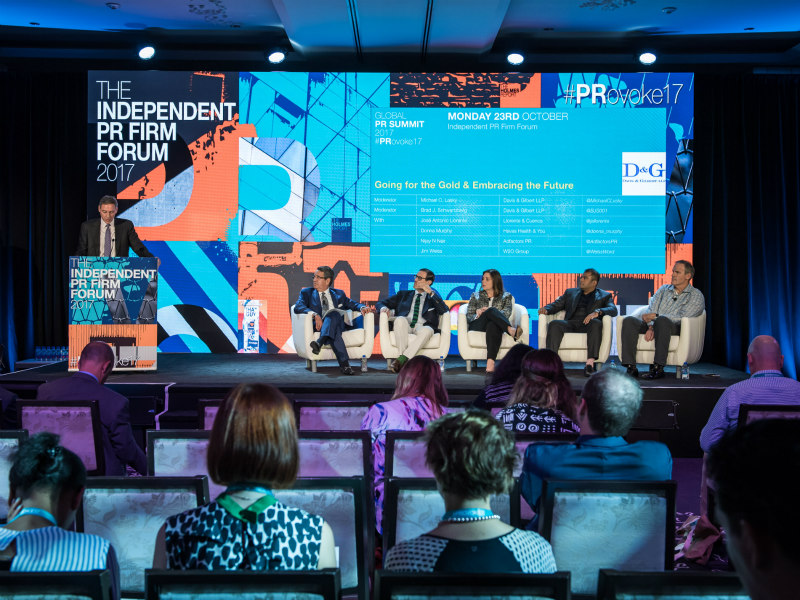Paul Holmes 23 Oct 2017 // 9:00PM GMT

MIAMI—The vast majority (92%) of independent public relations firms responding to a survey from law firm Davis & Gilbert and The Holmes Report have been approached about selling—up from 75% in the same survey last year—and 56% believe it is likely or very likely that they will sell their firms within the next three years (up from 50%).
But relatively few are looking to be absorbed by a giant holding company, according to the research, presented by Davis & Gilbert partner Brad Schwartzberg at the Independent PR Firm Forum in Miami. Most firms expressed a preference for being acquired by another independent PR firm, followed by a consulting firm and a private equity firm.
That jibes with Davis & Gilbert’s analysis of the market for PR firms last year, which found that 66% of buyers were independent PR firms (up from 57% in 2016), with just 29% of deals done by public holding companies (down from 39%).
Beyond the M&A arena, the D&G/Holmes research looked at opportunities and challenges and growth strategies for PR firms. It found that the number one challenge for most firms over the next 12 months is attracting and retaining talent, and the number one action firms have taken to address that challenge is bringing on board employees with expertise in content development and content marketing.
Not far behind in terms of important hiring practices were training employees to integrate data and measurement into account management and hiring employees with data and measurement experience.
In a panel discussion around the research, Jim Weiss, founder and CEO of W2O Group, talked about the way his business has integrated analytics: “I came out of Genentech and one of the things the CEO there taught us was to follow the data, which in that business leads to the best therapy. We use the same kind of analytical models to lead us to the best solution and save us time and money.”
The firm now employs 100 data scientists and analytics people and is now beginning to apply machine learning and other advanced techniques.
Nijay Nair, director at India’s Adfactors PR, said his firm had been applying new technology and analytics tools internally. “If technology can disrupt your business, it must also be true that new technology can help you disrupt the market you are in.”
“We don’t sell tech,” said José Antonio Llorente, founding partner and chairman of Llorente & Cuenca. “We sell advice and experience, but that has to be informed by technology.”
The number one change in terms of positive impact on revenue, meanwhile, involved integrating client teams to include people with expertise in PR, digital, social, creative, marketing, advertising and branding. Hiring specialized senior level talent to expand service offerings and reorganizing client teams to focus on specialized industry sectors were other successful challenges.
Donna Murphy, global CEO of Havas Health & You, said her firm had created “villages” that offer an integrated suite of services, with people from various disciplines focused on finding solutions for specific clients rather than on their own narrow niche.
Discussing changes at Adfactors, Nair says: “There are new positions that didn’t exist in the past—data scientists to help us understand the external environment but also help with internal decision making. There’s reskilling—we invested 2% of our profits into training and development. And there’s senior executives doing things differently—our CEO is now a chief culture officer too.”
The payoff for Adfactors has been the ability to move toward more value-based pricing. “We have been looking at value-based pricing and we have found that it works when three things combine: high uncertainty, high stakes and urgency,” said Nair.
Added Llorente, “We try to make sure everyone understands the digital work, to take people like journalists and lawyers and politicians and make sure they understand the technology.”
And Weiss concluded: “We have to be good at a lot of things. It’s great to have the data, but if we can’t write a proposal, if we can’t put a great creative idea in front of clients, it’s not going to help.”
Cultural issues remain important. At Havas Health & You, Murphy said, “We are very flat, and very entrepreneurial and we move very quickly. all the numbers are shared. Everyone has ownership. It creates a culture of partnership very quickly.”
At L&C, giving people the ability to take part of big decisions through real partnership—equity ownership—has been critical, Llorente said. “In our partnership, each partner has one vote, no matter how many shares they hold. It’s about the quality of leaders, not how much they own.”
Looking at acquisition strategy moving forward, Weiss said W2O would remain focused on digital and social and data and analytics acquisitions, particularly in the health space. Havas Health & You remains focused on healthcare, but will emphasize culture—including depth of ownership. Said Murphy, “We don’t want to do deals with individuals, we want to do deals with teams of people.”
Nair said that after three decades of organic growth, Adfactors continues to approach acquisitions conservatively—even though it has made three acquisitions over the past couple of years. “We look at what we are going to be tomorrow, and acquisitions have to be a strategic fit for that question. But buying a firm and integrating it are two different things.”
L&C will continue to focus on Latin America, said Llorente, Brazil, Mexico and Chile remain key markets, and the US Hispanic market is attractive too.


































.jpg)
















